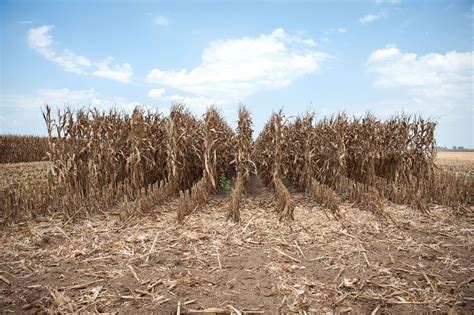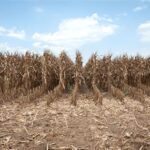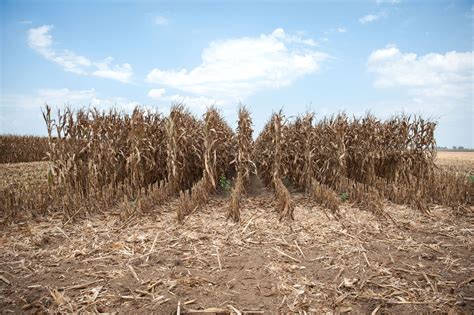
Farmers in several regions are facing catastrophic crop losses, with some reporting up to 90% devastation due to an unprecedented weather event characterized by alternating extreme heat, drought, and sudden, localized torrential rains. This devastating blow, which experts are calling one of the worst agricultural disasters in decades, threatens food security, farmer livelihoods, and potentially consumer prices.
The severity of the situation is underscored by the widespread impact across multiple states and a variety of crops. While specific regions and crops vary in the degree of damage, the overall picture painted by farmers and agricultural experts is grim. The erratic weather patterns, defying typical seasonal expectations, have left fields barren, harvests decimated, and farmers reeling from financial ruin.
“It’s just heartbreaking,” said John Miller, a corn and soybean farmer in Iowa, whose farm experienced nearly total crop failure. “We’ve never seen anything like this before. One week we’re praying for rain, and the next we’re battling flash floods. The crops just can’t handle it.”
The sudden and intense nature of the weather shifts has been particularly damaging. Prolonged periods of drought stressed plants to their breaking point, leaving them vulnerable to disease and unable to withstand subsequent deluges. In some areas, the torrential rains washed away topsoil and seedlings, effectively wiping out entire fields in a matter of hours.
Agricultural economists warn that the ripple effects of these crop losses could be far-reaching. Reduced yields will likely lead to higher prices for consumers, particularly for staples like corn, soybeans, and wheat. The impact will be felt not only domestically but also internationally, as the United States is a major exporter of these commodities. The reduction in supply could put pressure on global food prices, exacerbating food insecurity in already vulnerable regions.
Beyond the immediate economic consequences, the crop losses are also taking a heavy toll on farmers’ mental and emotional well-being. Many farmers are facing the prospect of losing their farms, their livelihoods, and their way of life. The stress and uncertainty surrounding the future are causing widespread anxiety and despair in rural communities.
Government agencies and agricultural organizations are working to provide assistance to affected farmers. Disaster relief programs are being activated, and efforts are underway to assess the full extent of the damage. However, the long-term recovery will require a sustained and coordinated effort from all stakeholders.
The current crisis highlights the growing vulnerability of agriculture to climate change. As extreme weather events become more frequent and intense, the need for climate-resilient farming practices and effective risk management strategies becomes increasingly urgent. Investing in research and development, promoting sustainable land management, and strengthening agricultural infrastructure are essential steps to mitigate the impacts of climate change on food production.
The losses also underscore the importance of crop diversification and the need to explore alternative crops that are better adapted to changing climate conditions. Farmers who have diversified their operations have generally fared better in the face of the recent weather extremes.
The situation remains fluid, and the full extent of the damage is still being assessed. However, it is clear that the agricultural sector is facing a major challenge. The coming months will be critical in determining the long-term impacts of these crop losses and in charting a path toward a more resilient and sustainable agricultural system.
Regional Impacts and Crop-Specific Losses
The geographic distribution of the crop losses is uneven, with some regions experiencing more severe damage than others. The Midwest, particularly Iowa, Illinois, and Nebraska, has been hit especially hard, as these states are major producers of corn and soybeans. The South has also seen significant losses, particularly in cotton and peanut crops.
Corn yields are projected to be down by as much as 40% in some areas, while soybean yields are expected to be 30% lower than average. Wheat crops have also suffered, with widespread reports of reduced yields and poor grain quality. The impact on livestock producers is also a concern, as higher feed prices will squeeze their profit margins.
In California, the ongoing drought has severely impacted fruit and vegetable production, leading to water restrictions and reduced yields. Farmers are struggling to keep their orchards and fields irrigated, and many are being forced to fallow land.
The variability in crop losses reflects the localized nature of the weather events. Some areas have experienced prolonged drought, while others have been inundated with excessive rainfall. The timing of these events has also been critical, as crops are most vulnerable to stress during certain stages of their development.
The economic consequences of these crop-specific losses are significant. Corn and soybeans are essential ingredients in animal feed, processed foods, and biofuels. Reduced supplies will drive up prices for these products, impacting consumers across the board. Wheat is a staple food for billions of people around the world, and reduced supplies could exacerbate food insecurity in developing countries.
Government Response and Disaster Relief
In response to the widespread crop losses, the federal government has activated disaster relief programs to provide assistance to affected farmers. These programs include low-interest loans, crop insurance payments, and direct payments to compensate farmers for their losses.
The U.S. Department of Agriculture (USDA) has also announced several initiatives to help farmers cope with the challenges of climate change. These initiatives include funding for research and development, technical assistance for sustainable farming practices, and incentives for farmers to adopt climate-resilient technologies.
However, some farmers argue that the government’s response has been inadequate. They say that the disaster relief programs are too slow and cumbersome and that the payments do not fully compensate them for their losses. They also call for more aggressive action to address climate change and to support sustainable agriculture.
State governments have also taken steps to assist farmers. Some states have established their own disaster relief funds, while others have provided technical assistance and educational programs to help farmers adapt to changing climate conditions.
The effectiveness of these government programs will depend on their ability to reach the farmers who need them most and to provide meaningful assistance in a timely manner. It will also depend on the willingness of policymakers to invest in long-term solutions to address the challenges of climate change.
The Role of Climate Change
The extreme weather events that have caused the recent crop losses are consistent with the predicted impacts of climate change. Scientists have long warned that climate change will lead to more frequent and intense heat waves, droughts, and floods, all of which can have devastating consequences for agriculture.
The increasing concentration of greenhouse gases in the atmosphere is trapping more heat, leading to a warming planet. This warming is disrupting weather patterns and causing more extreme weather events.
The agricultural sector is both a contributor to and a victim of climate change. Agricultural practices, such as deforestation and the use of fertilizers, contribute to greenhouse gas emissions. At the same time, agriculture is highly vulnerable to the impacts of climate change.
To address the challenges of climate change, the agricultural sector needs to reduce its greenhouse gas emissions and adapt to the changing climate conditions. This will require a combination of policy changes, technological innovations, and behavioral changes.
Sustainable farming practices, such as conservation tillage, cover cropping, and crop rotation, can help to reduce greenhouse gas emissions and improve soil health. Investing in research and development can lead to new technologies that can help farmers adapt to climate change. And educating farmers about the risks of climate change and the benefits of sustainable farming practices can encourage them to adopt more climate-resilient approaches.
The transition to a more sustainable and climate-resilient agricultural system will be a major challenge, but it is essential to ensure food security and protect the livelihoods of farmers in the face of a changing climate.
Long-Term Impacts and Future Outlook
The long-term impacts of the recent crop losses are uncertain, but they could be significant. Reduced yields could lead to higher food prices, increased food insecurity, and economic hardship for farmers and rural communities.
The crisis also raises questions about the sustainability of current agricultural practices. As climate change continues to disrupt weather patterns, farmers will need to adapt their farming practices to cope with more extreme conditions.
The future of agriculture will depend on the ability of farmers, policymakers, and researchers to work together to address the challenges of climate change. This will require a commitment to innovation, sustainability, and resilience.
Investing in research and development is essential to develop new crops and farming practices that are better adapted to changing climate conditions. Promoting sustainable land management can help to improve soil health and reduce greenhouse gas emissions. And strengthening agricultural infrastructure can help to protect crops from extreme weather events.
The challenges facing the agricultural sector are daunting, but they are not insurmountable. By working together, we can build a more resilient and sustainable agricultural system that can feed the world in the face of a changing climate.
Expert Opinions and Analysis
Agricultural experts and economists are warning that the current crisis could have long-lasting consequences for the agricultural sector and the broader economy.
“This is a wake-up call,” said Dr. Emily Carter, an agricultural economist at the University of California, Davis. “We need to take climate change seriously and invest in solutions to protect our food supply.”
“The current situation is a perfect storm of factors,” said Dr. David Thompson, a crop scientist at Iowa State University. “We’ve had extreme heat, drought, and floods, all in a very short period of time. This is putting unprecedented stress on our crops.”
“Farmers are resilient, but they can only take so much,” said Sarah Johnson, a farmer advocate with the National Farmers Union. “We need to provide them with the support they need to get through this crisis and to build a more sustainable future.”
The experts agree that the government needs to play a more active role in addressing the challenges of climate change and supporting sustainable agriculture. They also emphasize the importance of crop diversification, soil health, and water management.
“We need to move away from monoculture farming and towards more diverse and resilient cropping systems,” said Dr. Carter. “We also need to improve soil health so that our soils can better absorb water and withstand drought.”
“Water management is also critical,” said Dr. Thompson. “We need to invest in irrigation infrastructure and develop more efficient ways to use water.”
The experts are optimistic that the agricultural sector can adapt to climate change, but they caution that it will require a concerted effort from all stakeholders.
Individual Farmer Stories
The statistics and expert analyses paint a broad picture of the crisis, but the real impact is felt at the individual farm level. Farmers across the affected regions are struggling to cope with the devastation and to figure out how to move forward.
“I’ve been farming for 40 years, and I’ve never seen anything like this,” said John Miller, the corn and soybean farmer in Iowa. “I don’t know how I’m going to make it through this year.”
“We lost almost our entire crop to the floods,” said Maria Rodriguez, a vegetable farmer in California. “We’re not sure if we’ll be able to plant again next year.”
“It’s heartbreaking to see all our hard work go to waste,” said Tom Smith, a wheat farmer in Kansas. “We put our heart and soul into this farm, and now it’s all gone.”
These are just a few of the countless stories of farmers who are struggling to cope with the devastating crop losses. Their resilience and determination are inspiring, but they need support from the government, the agricultural industry, and the broader community.
The stories of these farmers underscore the human cost of the crisis and the importance of taking action to protect our food supply and support the livelihoods of those who produce it.
Insurance and Financial Implications
Crop insurance is designed to protect farmers from financial losses due to natural disasters, but the recent events have put the insurance system to the test. Many farmers are finding that their insurance policies do not fully cover their losses, leaving them with significant financial burdens.
The complexities of crop insurance policies and the challenges of assessing damage in the field have led to delays in payments and disputes over coverage. Some farmers are also facing higher insurance premiums in the future, making it even more difficult for them to stay in business.
The financial implications of the crop losses extend beyond the farm level. Rural communities that depend on agriculture for their economic well-being are also suffering. Businesses that supply farmers with inputs, such as seeds and fertilizers, are seeing reduced sales. And banks that have lent money to farmers are facing the risk of loan defaults.
The government is working to address the financial challenges facing farmers, but more needs to be done to ensure that they have access to adequate insurance coverage and financial assistance.
Technological Solutions and Innovations
Technology can play a critical role in helping farmers adapt to climate change and improve the resilience of their crops. Precision agriculture techniques, such as variable rate fertilization and irrigation, can help farmers to use resources more efficiently and reduce their environmental impact.
Drought-resistant and flood-tolerant crop varieties can help farmers to withstand extreme weather events. And early warning systems can help farmers to prepare for and mitigate the impacts of natural disasters.
Investing in research and development is essential to develop and deploy these technologies. The government and the private sector need to work together to ensure that farmers have access to the tools and resources they need to adapt to a changing climate.
Community Support and Mental Health
The crop losses are not only affecting farmers’ financial well-being, but also their mental and emotional health. The stress and uncertainty surrounding the future are causing widespread anxiety and despair in rural communities.
It is important for communities to come together to support farmers during this difficult time. Providing mental health services, organizing community events, and offering financial assistance can help farmers to cope with the challenges they are facing.
The mental health of farmers is often overlooked, but it is essential to their overall well-being and to the sustainability of the agricultural sector.
Conclusion: A Call to Action
The recent crop losses are a stark reminder of the vulnerability of agriculture to climate change. The challenges facing the agricultural sector are daunting, but they are not insurmountable. By working together, we can build a more resilient and sustainable agricultural system that can feed the world in the face of a changing climate.
This will require a commitment to innovation, sustainability, and resilience. It will also require a recognition of the human cost of the crisis and a willingness to support the farmers who are struggling to cope with the devastation.
The time for action is now. We need to invest in solutions to protect our food supply and support the livelihoods of those who produce it. The future of agriculture depends on it.
Frequently Asked Questions (FAQ)
-
What caused these widespread crop losses? The primary cause is an unprecedented weather event characterized by alternating extreme heat, drought, and sudden, localized torrential rains. These erratic weather patterns have severely stressed crops, leading to significant yield reductions and, in some cases, total crop failure.
-
Which regions are most affected by these crop losses? The Midwest, particularly Iowa, Illinois, and Nebraska, has been hit especially hard due to their significant production of corn and soybeans. The South has also experienced substantial losses, particularly in cotton and peanut crops. California’s fruit and vegetable production is also suffering due to ongoing drought conditions.
-
What is the government doing to help farmers affected by the crop losses? The federal government has activated disaster relief programs, including low-interest loans, crop insurance payments, and direct payments to compensate farmers for their losses. The USDA has also announced initiatives to support sustainable farming practices and climate-resilient technologies. State governments have also established disaster relief funds and provide technical assistance.
-
How will these crop losses affect consumers? Reduced crop yields will likely lead to higher prices for consumers, particularly for staples like corn, soybeans, wheat, fruits, and vegetables. The impact will be felt both domestically and internationally, as the United States is a major exporter of these commodities, and reduced supply could pressure global food prices.
-
What can be done to prevent similar crop losses in the future? Mitigation strategies include investing in climate-resilient farming practices (conservation tillage, cover cropping, crop rotation), promoting crop diversification, strengthening agricultural infrastructure, supporting research and development of drought-resistant and flood-tolerant crop varieties, and addressing climate change through policy changes and reducing greenhouse gas emissions. Community support and mental health services for farmers are also crucial.









